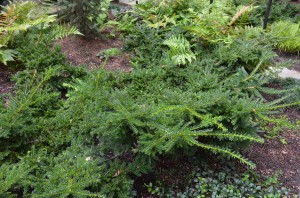Emerald Spreader® (Taxus x media ‘Monloo’) is a short wide-spreading Japanese yew. Emerald Spreader grows slowly, and may reach 2 ½ feet in height and 8 to 10 feet in spread over 20 years. The short 5/8 inch long, fine textured needles retain their rich dark green color through the winter months in USDA hardiness zones 6 and 7. Foliage may discolor from cold wintery winds in zones 4 and 5, unless protected.
Yews are classified as conifers and are separate sexes (“dioecious”). Female yew varieties bear green fleshy fruits called “arils” instead of cones. In early fall the green aril fruits ripen to bright red and are quite ornate in the fall-winter landscape.
Yews grow in average landscape soils and in full sun to partial shade. Good soil drainage is absolutely essential for yews. Provide adequate soil moisture during the first growing season to develop an extensive root system. Before new spring growth begins, feed with a general purpose fertilizer, such as 10-10-10.
Emerald Spreader is planted in low front borders such as home foundations or along walkways. At times branches may look rigid or stiff. Shearing 1-2 times during the growing season will soften their appearance. Do not prune yews during cold dry wintry intervals as to injure branches and needles.
Yews suffer from few insect or disease problems when properly sited. Root rots and plant deaths are common in poorly-drained soils. Yew foliage is poisonous and should not be planted if livestock are in close proximity. The seeds inside the aril fruits are also poisonous. Birds eat the fruits, but do not digest the seed. Deer and rabbits keep their distance from yews.


 Posted in
Posted in 
